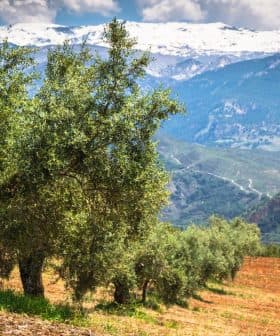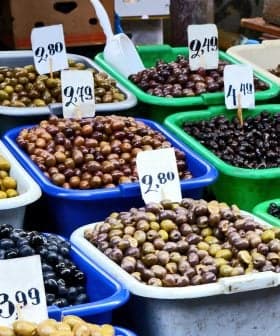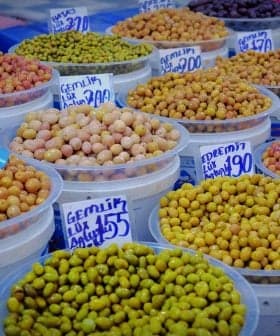Thessaloniki Conference Examines New Strategies for Greek Table Olive Sector
A meeting on the Greek table olive industry offered new strategies for the sector and revealed a mostly unknown and resilient cultivar with unique qualities.
A convention in Thessaloniki discussed the current state of the edible olives industry, focusing on the Greek sector which holds a leading position in international markets. Researchers highlighted a lesser-known olive cultivar, Kothreiki, with unique traits and potential health benefits, suggesting it could be marketed as a product for diabetics in the future. The event emphasized the need for new approaches to maintain competitiveness and meet the demands of global markets, with a focus on quality and innovation in the Greek olive industry.
A convention held in Thessaloniki last week examined the current status and presented the trends in the edible olives industry, focusing mostly on the Greek olive sector.
It was reaffirmed that Greek table olives occupy a leading position in international markets, but new approaches are required to maintain the momentum and to cope with the competition. An announcement from researchers that drew a lot of attention was about a not very popular olive cultivar with special characteristics and traits.
The two-day event was organized by the Krinos Olive Center of the Perrotis College and was hosted at the campus of the American Farm School. More than 250 producers, exporters, scientists, and other professionals of the table olives industry attended the convention to share their views.
Alexandros Georgiadis, president of the organizing committee and a food importer in America and Canada, said that the markets worldwide want a constant supply in quality and quantity and there is no room for price speculation with table olives as it has happened with olive oil. “The olives of the Chalkidiki variety have made big progress, exactly because producers have reacted properly to the demands of the markets,” he noted.
José Manuel Ruiz, sales manager of Interoliva S.A., reminded everyone that during the last 35 years the global production of table olives has increased three-fold in volume, and this is a proof of the product’s dynamics. Greece ranks fourth in the world in table olives exports, after Spain, Egypt, and Morocco, with more than 80 percent of the 250,000 tons of edible olives that are produced every year being exported to the US, Germany, Australia and elsewhere.
Another subject of the agenda was covered by Dan Flynn, the executive director of the UC Davis Olive Center, who presented the possible effects of climate change on table olives. He stated that a rise of 1.8°C to 2.0°C is expected in the Mediterranean Basin in the next 20 to 40 years, posing a significant challenge to Greek farmers.
Flynn explained that the prediction models have shown that the large cultivations of table olives will probably stay intact and 23 percent of the small cultivations in the country will be affected, particularly those that are not irrigated. He advised that irrigation must be properly managed to achieve better yields.
The value of Greek table olive exports is calculated at €450 million (approximately $525 million), but there is room for more; several participants pointed out that a shift in the mindset of the producers to present their customers not with a simple product but with something that is both attractive and easily accessible will further strengthen the status of Greek olives and grow their share in international markets.
To demonstrate this change in thinking the US market was examined, where imports of table olives are stable but consumption is declining. The household penetration of olives is low, especially in certain demographic groups of the country.
It was suggested that olives should be aligned with the special category of foods that bear health claims. A number of studies have demonstrated that there are benefits from eating olives due to their functional compounds and, as the scientists marked in the convention, table olives are one of the few fermented plant products that can carry probiotic bacteria.
This classification of olives will in turn appeal to the Millennials, who are the biggest consumer group of food products with a health claim, so they can be targeted as potential buyers of table olives. Another step is to channel olives online to different destinations to achieve penetration and be within arm’s reach for consumers.
Kalamata table olives represent a strong brand name in the sector and Chalkidiki olives are making steps forward, but another cultivar, Kothreiki, was the showstopper of the convention.
The trees of Kothreiki, which is also known as Manaki or Korinthiaki, can be grown at altitudes up to 900 meters and are able to withstand strong winds and relatively low temperatures. Their drupes can be used as edible olives or they can be processed in mills for oil.
A three-year research done by two Greek scientists analyzed the olives of the Kothreiki cultivar and they were found to contain a significant amount of phenolic compounds and an unusually high quantity of palmitoleic acid, measuring to more than 3.5 grams per 100 grams of fatty acids. Palmitoleic acid is a monounsaturated fatty acid which is considered beneficial for diabetics due to its regulatory effect on glucose and on the acceptance of the intake of insulin.
The idea was floated that the Kothreiki cultivar could carry a health claim for diabetics if and when the research is completed and the results are verified.
The Krinos Olive Centre was founded in 2013 to support the production of edible olives and olive oil in Greece. It has established partnerships with research institutes and companies of the sector including the Davis Olive Center.
This was the first convention organized by Krinos on the innovations of the table olive sector and participants pledged to meet again in Thessaloniki in 2020.









